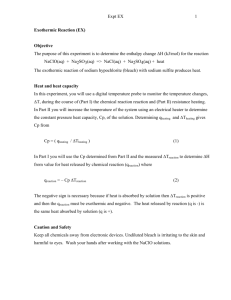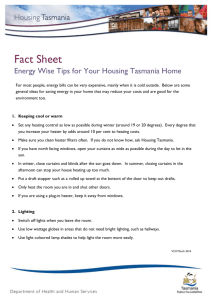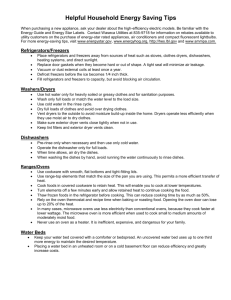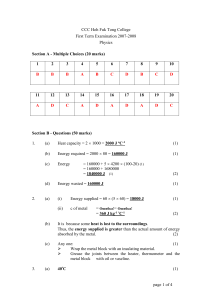QCP521_Koh_Chia_Ho_Specific_Heat_Capacity_Worksheet
advertisement
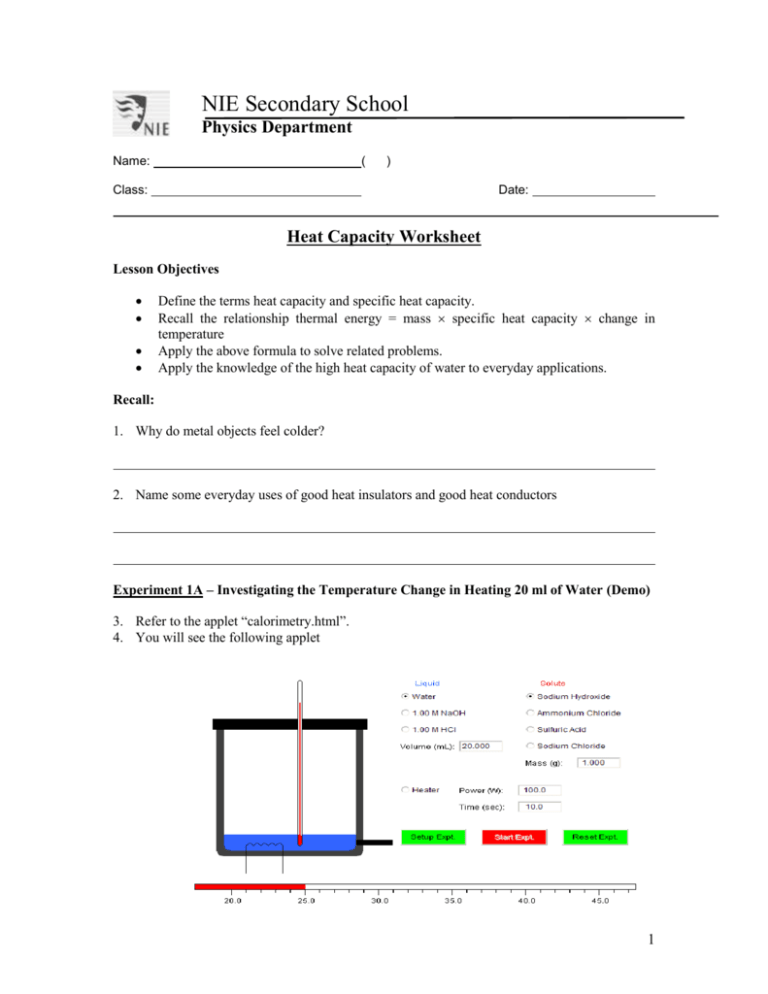
NIE Secondary School Physics Department Name: ( ) Class: Date: Heat Capacity Worksheet Lesson Objectives Define the terms heat capacity and specific heat capacity. Recall the relationship thermal energy = mass specific heat capacity change in temperature Apply the above formula to solve related problems. Apply the knowledge of the high heat capacity of water to everyday applications. Recall: 1. Why do metal objects feel colder? 2. Name some everyday uses of good heat insulators and good heat conductors Experiment 1A – Investigating the Temperature Change in Heating 20 ml of Water (Demo) 3. Refer to the applet “calorimetry.html”. 4. You will see the following applet 1 5. Settings used: Liquid = Water Volume of water used = 20.000 ml Power of Heater = 100.0 W Heating time = 10.0 sec Ignore the settings for “Solute” 6. What is the initial temperature of water? 7. What is the final temperature of water after heating? 8. Calculate the change in temperature of the water. 9. Calculate the amount of heat energy supplied Experiment 1B – Investigating the Temperature Change in Heating 40 ml of Water (Demo) 10. Refer to the same applet as Experiment 1A. 11. Settings used: Liquid = Water Volume of water used = 40.000 ml Power of Heater = 100.0 W Heating time = 10.0 sec Ignore the settings for “Solute” 12. What is the initial temperature of water? 13. What is the final temperature of water after heating? 14. Calculate the change in temperature of the water. 15. Compare this change in temperature to Experiment 1 A. Which is greater? 16. Calculate the amount of heat energy supplied Conclusion for Expt 1A and 1B 17. For the same amount of water have a different rise in temperature. supplied, different amounts of Experiment 2 – Investigating the Temperature Change in Heating Oil and Water For the following experiment, work in pairs. Students are assumed to be familiar with the use of dataloggers to measure temperature. Apparatus 1 beaker containing 400 ml of water 1 beaker containing 400 ml of cooking oil 2 immersion heaters (100 W) 2 temperature sensors connected to datalogger 2 18. Set up the apparatus as shown below. Heat 1 beaker of water (400 ml) and 1 beaker of cooking oil (400 ml) using an immersion heater for 5 minutes. Heater Heater Data Logger Water Oil 19. Observe the temperature changes via the data logger. Readings 20. Initial temperature of 400 ml of water Initial temperature of 400 ml of oil Final temperature of 400 ml of water Final temperature of 400 ml of oil Change in temperature of 400 ml of water Change in temperature of 400 ml of oil 21. Is the amount of heat supplied to both beakers the same? 22. Which liquid heated faster? 23. For the same amount of heat supplied, different substances show a different change in temperature. If we supply the same amount of heat to different amounts of the same substance, will the change in temperature be the same? Make a guess. 24. From Experiments 1A and 1B, we observe that the same amount of heat supplied to different amounts of the same substance (water in this case) cause different rise in temperature. From Experiment 2, we observe that the same amount of heat supplied to the same amounts of different substance (oil and water in this case) also cause a different rise in temperature. How do we measure how much heat will raise the temperature by how much? 3 Definition of Heat Capacity Heat Capacity is defined as the amount of of a substance by needed to raise the C or Kelvin Formula of Heat Capacity Heat Capacity, C Unit: More useful form: Q C T Exercises 25. When a piece of iron is heated from 30C to 60 C, the heat absorbed is 6000J. Calculate its heat capacity 26. A piece of copper has a heat capacity of 30 J/K. What is the amount of heat given out when it is cooled from 290 K to 200 K. 27. Given that the container (a.k,a calorimeter) in Experiments 1A and 1B has a heat capacity of 53.64 J/K, calculate the heat capacity of water in both experiments. Recall: Heat energy supplied by heater = power of heater × heating time. Total amount of heat supplied = Heat gained by container + heat gained by water 4 28. As we observed from Expt 2A and 2B, since the heat capacity of water is dependent on the amount of water, it is more meaningful to look at heat capacity per unit mass of a substance. Using the density of water as 1000 kg/m3, complete the table below. Heat capacity of water /JK-1 Mass of water/kg Heat Capacity Mass of water (J/kgK) Expt 2A Expt 2B 29. What do you observe about the ratio of the heat capacity to the mass of water? 30. Note that the heat capacity of 1 g of the same substance (in this case water) is always the same. This is called its Definition of Specific Heat Capacity Specific Heat Capacity is defined as the amount of raise the or of needed to of a substance by C Kelvin Formula of Specific Heat Capacity Specific Heat Capacity, c Unit: More useful form: Q m c T 5 Exercises 31. Based on your observations in Experiment 2, what can we say about the specific heat capacities of water and oil? Explain why we use oil in cooking with regards to its specific heat capacity. 32. A piece of iron of mass 5 kg has a heat capacity of 2220 J K-1. Find its specific heat capacity. 33. Find the amount of heat energy needed to raise the temperature of 500g of water from 0oC to 100oC. Take the specific heat capacity of water to be 4186 J/kg oC 34. Water has a very high specific heat capacity of 4186 J/kg oC. Comparatively, the heat capacity of copper is 385 J/kg oC. This means that water can absorb a lot of heat before raising its temperature by 1 oC. What are the applications that make use of the high specific heat capacity of water? 35. What are the differences between heat capacity and specific heat capacity of a substance? 6 Homework 1. J98/P1/Q14 Heat energy is supplied at the same rate to 100g of paraffin and 100g of water in similar containers. The temperature of the paraffin rises faster. This is because the paraffin. A. Is more dense than water. B. Is less dense than water. C. Evaporates less readily than water. D. Has smaller specific heat capacity than water E. Has larger specific heat capacity than water 2. N96/P1/Q15 The diagrams represent two blocks of copper, P and Q, each receiving the same amount of energy W. The mass of P is twice the mass of Q. The temperature rise of P is half the temperature rise of Q. Which statement about P and Q is correct? P Q Mass = 0.40kg Temperature rise = 20.0K Mass = 0.20kg Temperature rise = 40.0K The heat capacity of P is half the heat capacity of Q. A. The heat capacity of P is twice the heat capacity of Q. B. The specific heat capacity of P is half the specific heat capacity of Q. C. The specific heat capacity of P is twice the specific heat capacity of Q. 3. N90/P1/Q14 It takes 2 minutes to raise the temperature of 1.7 kg of water by 40oC using a 2.5kW heater. Assuming there are no heat losses, how long would it take to raise the temperature of 170 kg of water by the same amount using a 5.0 kW heater? 4. N98/P2/Q10(a) A Physics student wishes to measure the thermal energy from the Sun that falls on the surface of a lens. He sets up the experiment as shown in the figure. Sunlight is converged by a lens on to a blackened piece of metal, which absorbs all of the incident energy. The lens transmits all of the energy that falls on it. Thermometer Sun’s rays Lens Blackened piece of metal The mass of the block of metal is 0.020 kg and its specific heat capacity is 390 L/(kg K). The reading on the thermometer increases by 2.1 K in one minute. (i) Calculate the energy received by the block of metal in one minute. (ii) Calculate the power received by the block of metal. (iii) What other measurement does the student need to make in order to measure the thermal power from the Sun that falls on to a 1 cm2 area of the surface of the lens? 7


